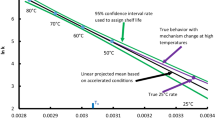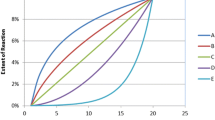Abstract
Purpose
To propose and test a new accelerated aging protocol for solid-state, small molecule pharmaceuticals which provides faster predictions for drug substance and drug product shelf-life.
Materials and Methods
The concept of an isoconversion paradigm, where times in different temperature and humidity-controlled stability chambers are set to provide a critical degradant level, is introduced for solid-state pharmaceuticals. Reliable estimates for temperature and relative humidity effects are handled using a humidity-corrected Arrhenius equation, where temperature and relative humidity are assumed to be orthogonal. Imprecision is incorporated into a Monte-Carlo simulation to propagate the variations inherent in the experiment. In early development phases, greater imprecision in predictions is tolerated to allow faster screening with reduced sampling. Early development data are then used to design appropriate test conditions for more reliable later stability estimations.
Results
Examples are reported showing that predicted shelf-life values for lower temperatures and different relative humidities are consistent with the measured shelf-life values at those conditions.
Conclusions
The new protocols and analyses provide accurate and precise shelf-life estimations in a reduced time from current state of the art.











Similar content being viewed by others
References
K. C. Waterman, and R. C. Adami. Accelerated aging: prediction of chemical stability of pharmaceuticals. Int. J. Pharm. 293:101–125 (2005).
F. J. Urban, V. J. Jasys, J. W. Raggon, R. A. Buzon, P. D. Hill, J. F. Eggler, and J. D. Weaver. Novel synthesis of 1-(1,2,3,5,6,7-hexahydro-s-indacen-4-yl)-3-[4-(1-hydroxy-1-methylethyl)furan-2-sulfonyl]urea, an antiinflammatory agent. Synth. Comm. 33(12):2029–2043 (2003).
B. Li, B. Andresen, M. F. Brown, R. A. Buzon, C. K.-F. Chiu, M. Couturier, E. Dias, F. J. Urban, V. J. Jasys, J. C. Kath, W. Kissel, T. Le, Z. J. Li, J. Negri, C. S. Poss, J. Tucker, D. Whritenour, and K. Zandi. Process development of CP-481715, a novel CCR1 antagonist. Org. Proc. Res. Dev. 9(4):466–471 (2005).
D. T. Friesen, M. J. Gumkowski, R. J. Ketner, D. A. Lorenz, J. A. S. Nightingale, R. M. Shanker, and J. B. West. Pharmaceutical compositions of dispersions of drugs and neutral polymers. Int. Patent Appl. WO 2003000235A1 (2003) p. 210.
M. M Hayward. Preparation of [(2-piperazinyl-2-oxoethoxy)phenyl]alkanesulfonic acids and analogs as CCR1 receptor antagonists for treatment of inflammation and immune disorders. Int. Patent Appl. WO2002102787A2, p. 44 (2002).
M. F. Brown, A. S. Gaweco, R. P. Gladue, and M. M. Hayward. Preparation of piperazine sulfonic acid derivatives as chemokine receptors CCR1 antagonists for the treatment of fibrosis, Alzheimer disease and other disorders Int. Patent Appl. WO2004039377A1, p. 56 (2004).
U. Kaufmann. Preparation of piperazine derivatives as CCR1 antagonists for the treatment of endometriosis. Int. Patent Appl. WO2005079769A2 pp. 291 (2005).
K. M. Alsante, P. Boutros, M. A. Couturier, R. C. Friedmann, J. W. Harwood, G. J. Horan, A. J. Jensen, Q. Liu, L. L. Lohr, R. Morris, J. W. Raggon, G. L. Reid, D. P. Santafianos, T. R. Sharp, J. L. Tucker, and G. E. Wilcox. Pharmaceutical impurity identification: A case study using a multidisciplinary approach. J. Pharm.Sci. 93(9):2296–2309 (2004).
T. Vlase, G. Vlase, and N. Doca. Thermal stability of food additives of glutamate and benzoate type. J. Therm. Anal. Calor. 80(2):425–428 (2005).
G. T. Long, S. Vyazovkin, N. Gamble, and C. A. Wight. Hard to swallow dry: kinetics and mechanism of the anhydrous thermal decomposition of acetylsalicylic acid. J. Pharm. Sci. 91(3):800–809 (2002).
S. Yoshioka and V. J. Stella. Stability of Drugs and Dosage Forms, Plenum, New York, 2000, pp. 108–113.
T. Hladon, B. Cwiertnia. The effect of humidity on the stability of diclofenac sodium in inclusion complex with ß-cyclodextrin in the solid state. Pharmazie 54(12):943–944 (1999).
D. Genton and U. W. Kesselring. Effect of temperature and relative humidity on nitrazepam stability in solid state. J. Pharm. Sci. 66:676–680 (1977).
M. Zajac. Stability of crystalline mecilliname sodium salt in the solid phase. Acta Pol. Pharm. 41:659–664 (1984).
M. C. Lai, M. J. Hageman, R. L. Schowen, R. T. Borchardt, and E. M. Topp. Chemical stability of peptides in polymers. 1. Effect of water on peptide deamidation in poly(vinyl alcohol) and poly(vinyl pyrrolidone) matrixes. J. Pharm. Sci. 88(10):1073–1080 (1999).
L. N. Bell and M. J. Hageman. Differentiating between the effects of water activity and glass transition dependent mobility on a solid state chemical reaction: aspartame degradation. J. Agric. Food Chem. 42:2398–2401 (1994).
Z. Plotkowiak. The effect of chemical character of certain penicillins on the stability of the ß-lactam group in their molecules. Pharmazie 44:837–839 (1989).
E. Pawelczyk, Z. Plotkowiak, and M. Helska. Kinetics of thermal decomposition of talampicillin hydrochloride in the solid state. Pharmazie 55(5):390–391 (2000).
F.Y. Tripet and U.W. Kesselring. Etude de stabilité de l-acide folique à l’état solide en function de la température et de l’humidité. Pharm Acta Helv. 50(10):318–322 (1975).
R. G. Strickley and B. D. Anderson. Solid-state stability of human insulin II. Effect of water on reactive intermediate partitioning in lyophiles from pH 2–5 solutions: stabilization against covalent dimmer formation. J. Pharm. Sci. 86(6):645–653 (1997).
Acknowledgments
The authors would like to acknowledge the assistance of Dr. Julie Lorenz for her helpful discussions and suggestions. The authors would also like to acknowledge the assistance of Yan Liu, Shilpa Naik and Yukun Ren, each of whom contributed to the programming of the Monte-Carlo simulation.
Author information
Authors and Affiliations
Corresponding author
Rights and permissions
About this article
Cite this article
Waterman, K.C., Carella, A.J., Gumkowski, M.J. et al. Improved Protocol and Data Analysis for Accelerated Shelf-Life Estimation of Solid Dosage Forms. Pharm Res 24, 780–790 (2007). https://doi.org/10.1007/s11095-006-9201-4
Received:
Accepted:
Published:
Issue Date:
DOI: https://doi.org/10.1007/s11095-006-9201-4




